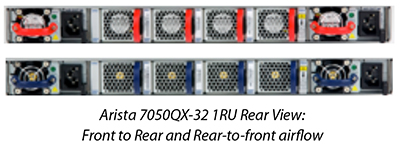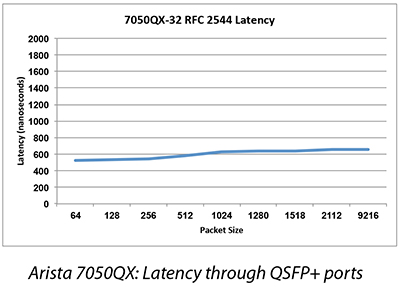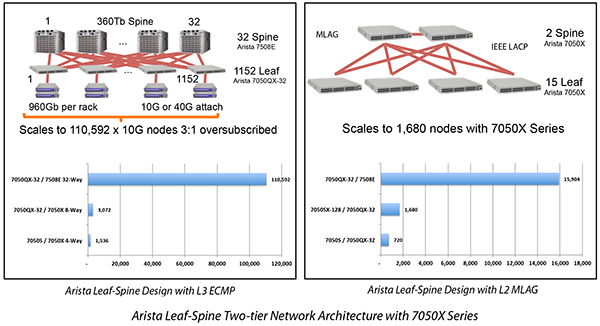Overview:
The Arista 7050QX-32 and 7050QX-32S are members of the Arista 7050X Series and
key components of the Arista portfolio of data center switches. The Arista 7050X
Series are purpose built 10/40GbE data center switches in compact and energy
efficient form factors with wire speed layer 2 and layer 3 features, combined with
advanced features for software defined cloud networking.
Increased adoption of 10 Gigabit Ethernet servers coupled with applications using
higher bandwidth is accelerating the need for dense 10 and 40 Gigabit Ethernet
switching. The 7050QX-32 and 7050QX-32S support a flexible combination of 10G
and 40G in a highly compact form factor that allows customers to design large leaf
and spine networks to accommodate east-west traffic patterns found in modern
data centers, high performance compute and big data environments.
Featuring 32 QSFP+ ports in a 1RU form factor the switches deliver feature rich layer
2 and layer 3 wire speed performance with an overall throughput of 2.56 Tbps. For
configuration flexibility both support up to 32x 40GbE ports or 24 QSFP+ ports can
be used as 4x10GbE for a 96x10GbE and 8x 40GbE system. In addition the
7050QX-32S features four SFP+ ports that are internally shared with the first QSFP+
port for directly connecting 10GbE and 1GbE interfaces. Both of the Arista 7050QX
switches offer low latency from 550ns in cut-through mode, and a shared 12 MB
packet buffer pool that is allocated dynamically to ports that are congested. With
typical power consumption of less than 5 watts per 40GbE port the 7050QX Series
provide industry leading power efficiency. An optional built-in SSD supports
advanced logging, data captures and other services directly on the switch.
Combined with Arista EOS the 7050QX Series delivers advanced features for big
data, cloud, virtualized and traditional designs.
Arista EOS
The Arista 7050X runs the same Arista EOS software as all Arista products,
simplifying network administration. Arista EOS is a modular switch operating system
with a unique state sharing architecture that cleanly separates switch state from
protocol processing and application logic. Built on top of a standard Linux kernel, all
EOS processes run in their own protected memory space and exchange state
through an in-memory database. This multi-process state sharing architecture
provides the foundation for in-service-software updates and self-healing resiliency
With Arista EOS, advanced monitoring and automation capabilities such as Zero Touch Provisioning, VMTracer and Linux based tools can be run natively on the switch with the powerful x86 CPU subsystem.
Product Highlights
Performance
- 7050QX-32: 32x40GbE ports
- 7050QX-32S: 32x40GbE ports and 4x10GbE
- Up to 2.56 terabits per second
- Up to 1.44 billion packets per second
- Wire speed L2 and L3 forwarding
- Latency from 550ns
Data Center Optimized Design
- Typical power of 5W per 40GbE port for lower cost of ownership
- Over 92% efficient power supplies
- 1+1 redundant & hot-swappable power
- N+1 redundant & hot-swappable fans
- Front-to-rear or rear-to-front cooling
- Tool less rails for simple installation
Cloud Networking Ready
- VXLAN and VM Tracer
- OpenFlow, DirectFlow and eAPI
- 288K MAC entries
- 144K IPv4 Routes
- 208K IPv4 Host Routes
- 12MB Dynamic Buffer Allocation
Resilient Control Plane
- Dual-core x86 CPU
- 4GB DRAM
- Up to 4GB Flash
- User applications can run in a VM
|
Built-in Solid State Storage
- 100GB Solid State Drive option
- Store logs and data captures
- Leverage linux tools with no limitations
Advanced Provisioning & Monitoring
- Zero Touch Provisioning (ZTP)
- LANZ for microburst detection
- DANZ Advanced Mirroring for visibility
- sFlow
- Self-configure and recover from USB
Arista Extensible Operating System
- Single binary image for all products
- Fine-grained truly modular network OS
- Stateful Fault Containment (SFC)
- Stateful Fault Repair (SFR)
- Full Access to Linux shell and tools
- Extensible platform - bash, python, C++
|
Benefits:
High Availability

The Arista 7050X series switches were designed for high availability from both a software and hardware perspective. Key high availability features include:
- 1+1 hot-swappable power supplies and four N+1 hot-swap fans
- Color coded PSU’s and fans - common to Arista 1RU devices
- Live software patching
- Self healing software with Stateful Fault Repair (SFR)
- Smart System Upgrade (SSU) and Accelerated Software Update (ASU)
- Up to 64 10GbE ports per link aggregation group (LAG)
- Multi-chassis LAG for active/active L2 multi-pathing
- 64-way ECMP routing for load balancing and redundancy

Dynamic Buffer Allocation
In cut-through mode, the Arista 7050X switches forward packets with a latency of 550 nanoseconds to 650 nanoseconds. Upon congestion, the packets are buffered in shared packet memory that has a total size of 12 Mbytes. Unlike other architectures that have fixed per-port packet memory, the 7050X Series use Dynamic Buffer Allocation (DBA) to allocate up to 6.7MB of packet memory to a single port for lossless forwarding.
Scaling Data Center Performance
The Arista 7050X series delivers line rate switching at layer 2 and layer 3 to enable faster and simpler network designs for data centers that dramatically lowers the network capital and operational expenses. When used in conjunction with the Arista 7000 series of fixed and modular switches it allows networks to scale to over 110,000 10G servers in low-latency two-tier networks that provide predictable and consistent application performance. The flexibility of the L2 and L3 multi-path design options combined with support for open standards provides maximum flexibility, scalability and network wide virtualization. Arista EOS advanced features provide control and visibility with single point of management.

Maximum Flexibility for Scale Out Network Designs
Scale out network designs enable solutions to start small and evolve over time. A simple two-way design can grow as far as 64-way without significant changes to the architecture. The Arista 7050X include enhancements that allow for flexible scale-out designs:
- 64-way ECMP and 64-way MLAG to provide scalable designs and balance traffic evenly across large scale 2 tier leaf-spine designs
- Custom hash algorithms for efficient hashing, persistent hashing and custom lookups for tunneled protocols.
- Flexible allocation of L2 and L3 forwarding table resources for more design choice
- Wide choice of dense 10G/40G ports for single port multi-speed flexibility
- VXLAN routing, bridging and gateway for physical to virtualization communication to enable next generation data center designs
- DANZ, sFlow and multi-port mirroring to detect micro-burst congestion and provide network wide visibility and monitoring
Software Defined Networking
Arista Software Defined Cloud Networking (SDCN), combines the principles that have made cloud computing the unstoppable force that it is: automation, self service provisioning, and linear scaling of both performance and economics coupled with the trend in Software Defined Networking that delivers: network virtualization, custom programmability, simplified architectures, and lower capital expenditure. This combination creates a best-in-class software foundation for maximizing the value of the network to both the enterprise and service provider data center. A new architecture for the most mission-critical location within the IT infrastructure that simplifies management and provisioning, speeds up service delivery, lowers costs and creates opportunities for competitive differentiation, while putting control and visibility back in the hands of the network and systems administrators.
Smart System Upgrade
Smart System Upgrade is a network application designed to address one of the most complicated and challenging tasks facing data center administrators - network infrastructure maintenance. Changes to the underlying network infrastructure can affect large numbers of devices and cause significant outages. SSU provides a fully customizable suite of features that tightly couples data center infrastructure to technology partners allowing for intelligent insertion and removal, programmable updates to software releases and open integration with application and infrastructure elements.
Advanced Event Management (AEM)
Simplifying the overall operations, AEM provides the tools to customize alerts and actions. AEM is a powerful and flexible set of tools to automate tasks and customize the behavior of EOS and the operation of the overall data center switching infrastructure. AEM allows operators to fully utilize the intelligence within EOS to respond to real-time events, automate routine tasks, and automate actions based on changing network conditions.
Enhanced Features for High Performance Networks
The Arista 7050QX deliver a suite of advanced traffic control and monitoring features to improve the agility of modern high performance environments, with solutions for data monitoring, and next-generation virtualization.
Precise Data Analysis
Arista Latency Analyzer (LANZ) is an integrated feature of EOS. LANZ provides precise real-time monitoring of micro-burst and congestion events before they impact applications, with the ability to identify the sources and capture affected traffic for analysis.
Virtualization
Supporting next-generation virtualized data centers requires tight integration with orchestration tools and emerging encapsulation technologies such as VXLAN. The 7050QX builds on the valuable tools already provided by the Arista VM Tracer suite to integrate directly into encapsulated environments. Offering a wire-speed gateway between VXLAN and traditional L2/3 environments, the 7050X makes integration of non-VXLAN aware devices including servers, firewalls and load-balancers seamless and provides the ability to leverage VXLAN as a standards based L2 extension technology for non-MPLS environments.
Unified Forwarding Table
Cloud network scalability is directly impacted by the size of a switches forwarding tables. In many systems a 'one size fits all' approach is
adopted using discrete fixed size tables for each of the common types of forwarding entry. The Arista 7050X leverages a common
Unified Forwarding Table for the L2 MAC, L3 Routing, L3 Host and IP Multicast forwarding entries, which can be partitioned per entry
type. The ideal size of each partition varies depending on the network deployment scenario. The flexibility of the UFT coupled with the
range of pre-defined configuration profiles available on the 7050X ensures optimal resource allocation for all network topologies and
network virtualization technologies.






